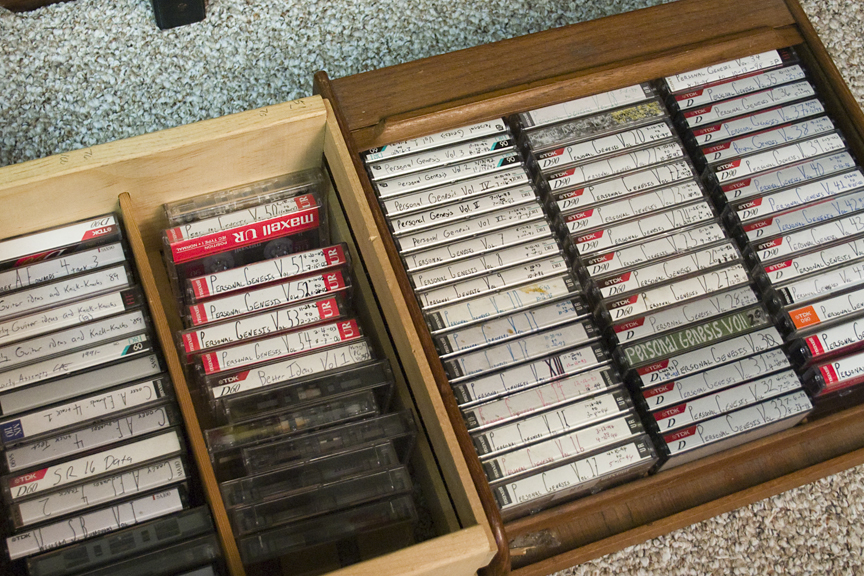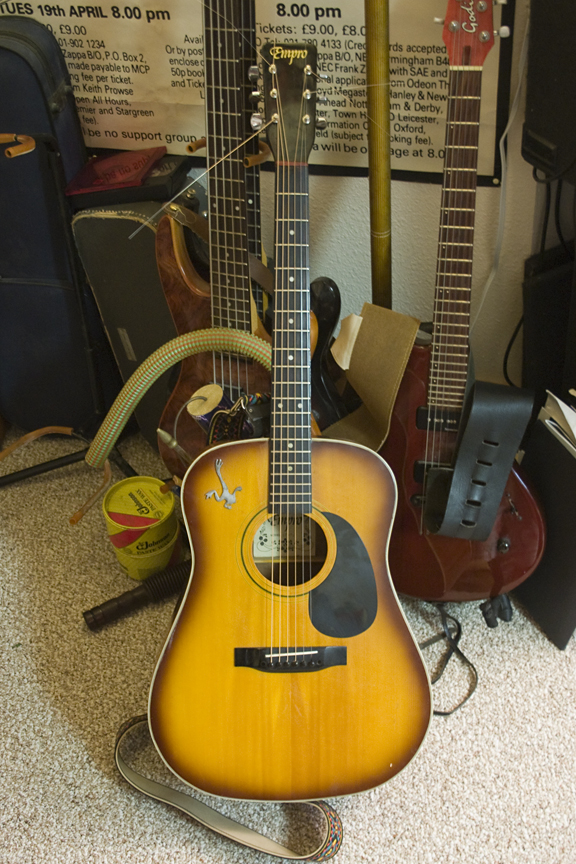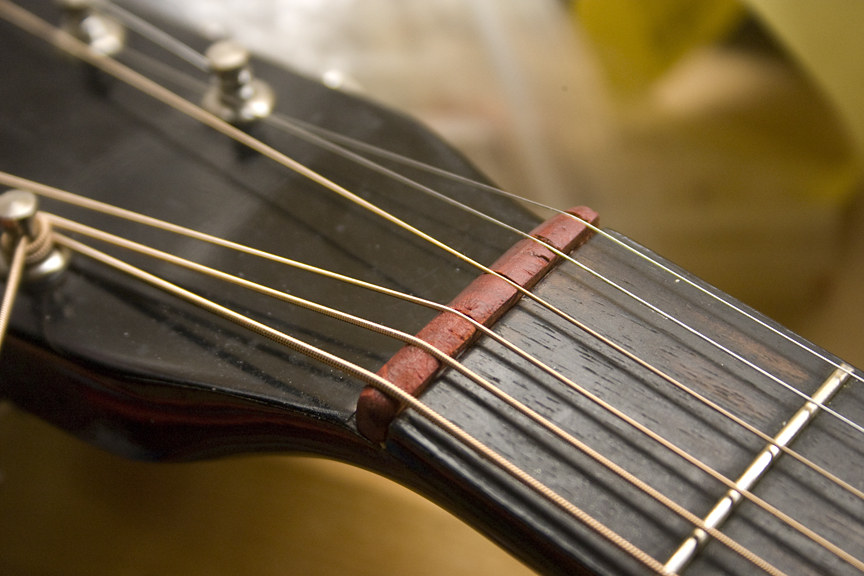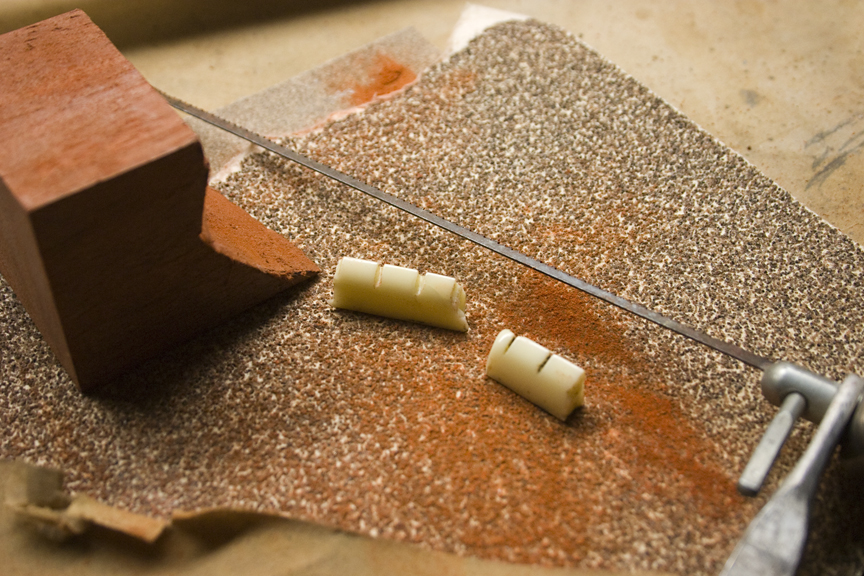In recent months, after purchasing some much needed nylon strings for my classical guitar and seeing a youtube video of one of my old songs starting to get some small notice, my interest in composition and pleasure-tweedling, long dormant, was rekindled.
 In response, I started going through my music diary in search of nuggets in the scree (and there’s a lot of scree, folks). During the perusal, I heard among the other instruments the occasional twang of phosphor bronze and felt myself hankering to once again inflict upon myself the pain and frustration of the steel-string experience.
In response, I started going through my music diary in search of nuggets in the scree (and there’s a lot of scree, folks). During the perusal, I heard among the other instruments the occasional twang of phosphor bronze and felt myself hankering to once again inflict upon myself the pain and frustration of the steel-string experience.
The very first acoustic guitar I ever got is an old, POS steel-string Empro that I picked up for $15 from a helpless stoner back in ’89 or thereabouts and, by some kind of strange default, has remained with me longer than any other guitar I’ve owned. Electric guitars have come and gone – from Flying V to Explorer to Steinberger to Stratocaster – but this horrible, old steel-string has stayed with me. I call this fact strange because playing the thing has always been a major struggle. It’s ever been stiff and unyielding with action that would please a tightrope walker but a guitarist? Not so much …
 Back when I was just beginning to play, it provided me with calluses so thick they’d buckle, split and peel off in yellowish, withered chunks, exposing tender, pink baby skin underneath that kept me from playing for days. Had it remained my only guitar, I don’t think I would have ever continued what amounted more to self-injury than a hobby.
Back when I was just beginning to play, it provided me with calluses so thick they’d buckle, split and peel off in yellowish, withered chunks, exposing tender, pink baby skin underneath that kept me from playing for days. Had it remained my only guitar, I don’t think I would have ever continued what amounted more to self-injury than a hobby.
Still, it’s stayed with me and, like an old, smelly, unpredictably viscous, three-legged dog with fleas, mange, and one eye, you end up just kind of adopting some things, no matter the facility of their configuration. You end up looking upon them with a fondness that … makes no sense, really but there you have it.
But that doesn’t mean you play with said dog – so pestiferous was this guitar that, since 2005 at least if not longer, it has lain unplayed and, out of deference to the survival of its neck, unstringed.
Deciding once again to hear its twang in my ears, feel its bite on my fingers, I buy a set of strings and begin the process of bringing it back to life.
Oh, the painful tedium of stringing a guitar: why have I never bought a string winder?
Having set each string at a basic tension, I begin to tune. Low E first, then high, and so on across the neck, back and forth, I tighten until I am somewhere near proper tension. I have in mind to improve the action via the truss rod and so study the guitar’s neck – does it suffer from backbow or relief? Upon initial stringing, the low E buzzes, so backbow. I make some truss rod adjustments until the buzzing ceases then make to tune again.
At the turn of the low E tuning key, the nut explodes.
The nut is the little bar at the top of the neck, between the headstock and the fretboard, which guides the strings and keeps them in place above the fretboard – and mine is now in three pieces, one of which I have yet to find. A bit of a setback, really.
So I do what anyone would do – I post about the experience on Facebook, then start looking online for replacement nuts.
There are numerous to choose from: different types, different measurements, different prices. I measure what’s left of mine and find its dimensions sightly different than all I find online (Empro seems to be a guitar company with a bit of a mysterious history, at least on the internet). With the cheapest replacement nut coming in at $6 a pop before shipping (for a tiny chunk of plastic!) without my being sure it will fit, I hesitate to buy but remain itchy with impatience – I wanna play!
Then it hits me: make one.
I happen to have scraps of paduak from an aborted guitar-blank project that, while perhaps not being ideally resonant, might be hard enough to work nicely; I set to work.
In under an hour of easy labor I have my prototype fitted in place and happily affix it with a bead of Liquid Nails (hey, I’m a pro, dammit) but, upon tightening the strings, discover that I have created a graded nut i.e.; the low E is suspended well above the fretboard, the following A, too, though at a lesser height, and so on across the neck to the G, B, and high E which are at a very playable level. grumble grumble …
 I remove the nut, clean off the glue residue from both it and the headstock, then go back to hand-sanding the nut into better shape. The amount I need to sand off is huge in the world of guitar action but minute in the way of actual labor and, in my vigor, I take it down a little further than I had intended to. Shit – I hope I didn’t just screw it up! I resolve to give it a try, anyway and, lo and behold, it not only works but, after a little more truss rod adjustment, the action is better than it ever has been before!
I remove the nut, clean off the glue residue from both it and the headstock, then go back to hand-sanding the nut into better shape. The amount I need to sand off is huge in the world of guitar action but minute in the way of actual labor and, in my vigor, I take it down a little further than I had intended to. Shit – I hope I didn’t just screw it up! I resolve to give it a try, anyway and, lo and behold, it not only works but, after a little more truss rod adjustment, the action is better than it ever has been before!
I don’t know how long this nut will last – there’s a good chance the strings will cut down into it and render it useless in a short period of time and, really, I did rush the job – it isn’t exactly a precision guitar part but, for now, it’s perfect.
Here’s to DIY!

